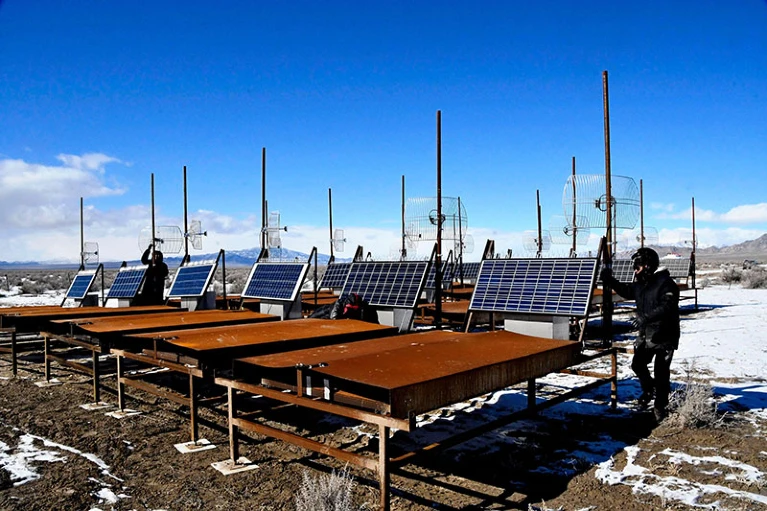Weird tasmanian devil lovebot baffles astronomers
Is that the right pronunciation of LFBOTs? Anyway, it is clearly aliens.
An explosion in space nicknamed the Tasmanian devil has confused astronomers by flashing at peak brightness more than a dozen times, months after the initial event. The observation, while posing new questions, could help to narrow down what might cause such explosions, which are known as luminous fast blue optical transients (LFBOTs).
LFBOTs are seen across the Universe and defy explanation. The first, dubbed the Cow after its designation AT2018cow, was spotted in 2018 in a galaxy about 60 million parsecs (200 million light years) from Earth. The Cow was notable for being up to 100 times brighter than a supernova before dimming over just a few days, a process that takes weeks for a supernova.
More than half a dozen LFBOTs have since been found, including ones referred to as the Koala, the Camel and, earlier this year, the Finch. But astronomers are still not sure what is causing them. The leading ideas are that these explosions are either failed supernovae — stars collapsing into a black hole or neutron star before they can explode — intermediate-mass black holes consuming other stars, or the results of objects interacting with hot, bright stars known as Wolf-Rayet stars.
In a study published on 15 November in Nature1, a team led by astronomer Anna Ho at Cornell University in Ithaca, New York, describes new activity from an LFBOT that had been discovered about 1 billion parsecs away in September 2022; this one, formally called AT2022tsd, is known as the Tasmanian devil. Initially using the Magellan-Baade telescope in Chile, the researchers found that the Tasmanian devil repeatedly flashed at its peak brightness, starting in December 2022. They saw 14 of these flaring events in total, each lasting only minutes.
“Flashes like this haven’t been seen before in LFBOTs,” says Ho. She adds that each of the unexpected flares was “as powerful as the original LFBOT”.
Ho says that the flaring could support the failed supernova idea, which would involve a massive star about 20 times the mass of the Sun running out of fuel and collapsing, leaving a dense neutron star or black hole inside the remains of the surrounding star. “We think these flashes are probably coming from either a neutron star or a black hole that was formed in the original LFBOT event,” she says.
If the neutron star or black hole at the centre of the LFBOT had powerful jets of energy firing from its poles, it could explain the flaring. These jets would fire out into space as the object rotated — and, if they repeatedly pointed in the direction of Earth, that could explain the flashes of light from the Tasmanian devil. “This could be one of the few cases where it was directed to us,” says Ho.
Brian Metzger, an astrophysicist at Columbia University in New York City, says that the observation is “quite striking” and “sort of confirms what we had concluded based on other evidence” — namely, that LFBOTs involve electrons that are travelling close to the speed of light being “heated or accelerated in some form of outflow”.
Further observations could help to determine the mass of the object, which could definitively explain its origin. “An intermediate mass black hole is a 10,000-solar-mass black hole,” says Ho. “A failed supernova is more like 10 or 100 solar masses.” The flares could offer a way to work out the mass of the object, she adds. “When you measure a fast-varying signal, you can use how quickly that signal is varying to estimate the size of the object emitting the signal.” A high speed would indicate that the object is rapidly rotating — suggesting a lower mass.
Is that the right pronunciation of LFBOTs? Anyway, it is clearly aliens.
An explosion in space nicknamed the Tasmanian devil has confused astronomers by flashing at peak brightness more than a dozen times, months after the initial event. The observation, while posing new questions, could help to narrow down what might cause such explosions, which are known as luminous fast blue optical transients (LFBOTs).
LFBOTs are seen across the Universe and defy explanation. The first, dubbed the Cow after its designation AT2018cow, was spotted in 2018 in a galaxy about 60 million parsecs (200 million light years) from Earth. The Cow was notable for being up to 100 times brighter than a supernova before dimming over just a few days, a process that takes weeks for a supernova.
More than half a dozen LFBOTs have since been found, including ones referred to as the Koala, the Camel and, earlier this year, the Finch. But astronomers are still not sure what is causing them. The leading ideas are that these explosions are either failed supernovae — stars collapsing into a black hole or neutron star before they can explode — intermediate-mass black holes consuming other stars, or the results of objects interacting with hot, bright stars known as Wolf-Rayet stars.
In a study published on 15 November in Nature1, a team led by astronomer Anna Ho at Cornell University in Ithaca, New York, describes new activity from an LFBOT that had been discovered about 1 billion parsecs away in September 2022; this one, formally called AT2022tsd, is known as the Tasmanian devil. Initially using the Magellan-Baade telescope in Chile, the researchers found that the Tasmanian devil repeatedly flashed at its peak brightness, starting in December 2022. They saw 14 of these flaring events in total, each lasting only minutes.
“Flashes like this haven’t been seen before in LFBOTs,” says Ho. She adds that each of the unexpected flares was “as powerful as the original LFBOT”.
Ho says that the flaring could support the failed supernova idea, which would involve a massive star about 20 times the mass of the Sun running out of fuel and collapsing, leaving a dense neutron star or black hole inside the remains of the surrounding star. “We think these flashes are probably coming from either a neutron star or a black hole that was formed in the original LFBOT event,” she says.
If the neutron star or black hole at the centre of the LFBOT had powerful jets of energy firing from its poles, it could explain the flaring. These jets would fire out into space as the object rotated — and, if they repeatedly pointed in the direction of Earth, that could explain the flashes of light from the Tasmanian devil. “This could be one of the few cases where it was directed to us,” says Ho.
Brian Metzger, an astrophysicist at Columbia University in New York City, says that the observation is “quite striking” and “sort of confirms what we had concluded based on other evidence” — namely, that LFBOTs involve electrons that are travelling close to the speed of light being “heated or accelerated in some form of outflow”.
Further observations could help to determine the mass of the object, which could definitively explain its origin. “An intermediate mass black hole is a 10,000-solar-mass black hole,” says Ho. “A failed supernova is more like 10 or 100 solar masses.” The flares could offer a way to work out the mass of the object, she adds. “When you measure a fast-varying signal, you can use how quickly that signal is varying to estimate the size of the object emitting the signal.” A high speed would indicate that the object is rapidly rotating — suggesting a lower mass.











